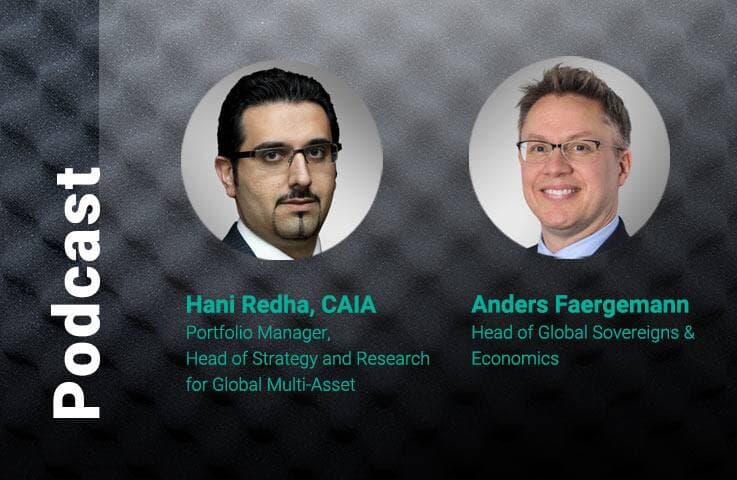Capital Market Line: Signs Are Pointing East

Michael J. Kelly, CFA
Global Head of Multi-Asset

Steven Lin, CFA
Portfolio Manager, Global Multi-Asset

Sunny Ng, CFA
Portfolio Manager, Global Multi-Asset

Mikhail Johaadien
Research Analyst, Global Multi-Asset

Hani Redha, CAIA
Portfolio Manager, Head of Strategy and Research for Global Multi-Asset

Peter Hu, CFA, FRM
Portfolio Manager, Global Multi-Asset

In terms of the policy mix, the post-Covid cycle is shaping up to be virtually the opposite of what we saw during the post-financial-crisis balance sheet recession and aftermath. The pandemic acted as a tipping point, pushing toward structurally tighter labor markets, less globalization, and greater fiscal assertiveness, especially in the US. Output gaps notched up from structurally loose to structurally tight, once again primarily in the US.
After an initial burst of inflation, prices until recently have been slow and sticky coming down, even as supply chain constraints cleared much faster (see chart). This likely reflects the structural inflation forces mentioned above, all with legs from here, being more than offset by the clearing of supply chain constraints for the time being. Nonetheless, the pace of disinflation has recently stepped up. The question is whether this is from a boost in productivity and supply, or the beginning of weaker demand. Prices always have a story behind them. The former could lead us back to disinflationary Goldilocks days. The latter would more likely indicate an upcoming cyclical downshift – even if in the midst of structural inflationary forces – and is more likely, in our view.
Global Supply Chain Pressure Index (NY Fed)

Source: Bloomberg as of 30 June 2023
In 2023, evolving weakness in private sector employment has been masked by delayed yet accelerating post-Covid fiscal thrusts; these were authorized long ago yet have only kicked into high gear in the past few quarters with respect to outlays, and the jobs that follow (see chart). Government stimulus programs, such as the Infrastructure Investment and Jobs Act (IIJA) launched in 2021, have allocated roughly $1 trillion over 10 years, and tax credit incentives under the CHIPS and Inflation Reaction Acts have spurred private sector investments in green technology and domestic manufacturing. This fiscal impulse is likely cresting here. To the extent that its acceleration begins to flatline, underlying private sector weakness will begin to come through. This would first appear as stepped-up disinflation, without necessarily having a discernible impact on taming the more structural medium-term drivers likely to keep inflation in a 2.5-3% band (versus the good old days of 1.5-2%).
Job Growth by Category

Source: Bloomberg as of 30 June 2023
Into this new landscape, the Fed is performing a balancing act, mopping up its prior contribution to inflation by keeping rates higher for longer, while sticking with quantitative tightening (QT) well beyond its hike-and-hold period. Monetarily, even if the Fed begins cutting rates next year, the cycle ahead looks far more restrictive than the super loose post-GFC days.
When we look at China, a different dynamic emerges. While most think in terms of two policy levers (monetary and fiscal), all countries have a third: the regulatory lever. China has used its regulatory lever far more aggressively (in both directions) than other countries. In the past seven years it has restrained more often than eased its regulatory levers. Examples of such restraint have been supply-side cuts of dirty industrial plants in 2015, shadow banking restraints in 2018, and crackdowns on technology, education, gaming, property, and the spread of Covid in 2021-2022.
The most recent batch proved too harsh for the economy, pushing it into recession as others were overheating. Yet since November, we have seen a string of pragmatic adjustments, marked by the loosening of a growing number of regulatory levers, with more to come. We also need to remember that in the past decade, China’s monetary policy was very tight while others were super-loose, with the aim of restraining its property bubble. Today, the concern is that property prices might begin to fall in an uncontrolled manner, inducing a balance sheet recession and a “lost decade.” As a result, we expect policy rates, as well as China’s managed currency, to continue easing.
Of course, Chinese equity fundamentals do face ongoing challenges from the decoupling of US-China technology, supply chains, and currency blocs. We expect the state of hegemonic rivalry in US-China relations to persist – though severing supply chains is tougher to effect than meets the eye. Only four Asian countries support the US sanctions on Russia. China and India freely buy oil from Russia and resell globally. Not a single Middle Eastern or Latin American country supports the sanctions on Russia either, and they increasingly buy oil from Russia in their own currencies. One has to wonder, with the global south purchasing technology from the US, how porous these restraints on China will prove to be. It will be a drag, but perhaps not an excessive one.
Countries and corporations are still diversifying supply chains away from China and moving operations closer to home or to politically aligned nations. Beneficiaries include Mexico, India, and Vietnam, among others. Strategic industries such as semiconductors, industrial automation, and batteries are at the forefront of national security-oriented intended restraints. In the US alone, over $250 billion of investments in near-shoring are expected over the next five years, signifying a rise in future US manufacturing production. Increasing factory automation to combat labor shortages is boosting related suppliers, including IoT (Internet of Things) and machine vision technology providers, enhancing automation and plant efficiency. And the recent launch of generative AI platforms like ChatGPT could also feed into these trends.
Overall, should the US manage through with only a mild recession, global goods production – currently running well below retail demand – will eventually rebound. The greatest beneficiary of this would be Asia, particularly China. With all the crosscurrents, we believe the East is in a far better cyclical position than the West. After significant outperformance in the last decade, the West is very expensive vis-à-vis emerging markets. While mean reversion-orientated valuation techniques have suggested the same for nearly two decades now, we believe each cycle needs to be treated as its own mean. For the first time in nearly a decade, our valuation work indicates that emerging markets are more attractive than developed markets. We also see the growth gap moving in EM’s favor as policy restraints begin to bite in the expensive West, while nurturing policy begins to take hold in the defensively priced East. Our Capital Market Line supports a “Go East” investment tilt.
Capital Market Line as of 30 June 2023 (Local Currency)

Capital Market Line as of 30 June 2023 (USD View, Unhedged)

Please see Capital Market Line Endnotes. Note that the CML’s shape and positioning were determined based on the larger categories and do not reflect the subset categories of select asset classes, which are shown relative to other asset classes only.
Insights From Today’s CML
A flat Capital Market Line (CML) with a high level of dispersion. Our CML continues to exhibit a flattish slope and downward trend compared to historical levels, as the withdrawal of liquidity remains a particularly challenging and broad-based headwind for valuations as well as growth of cash flows. Fortunately, there is a noticeable level of dispersion in the market, which further underscores the importance of careful asset class selection.
Developed market (DM) government bonds are slightly unattractive on a relative basis but provide better hedging benefits than in 2022, when they moved in sync with equities. That said, these yields are still significantly improved from the last cycle and will provide better hedging behavior during risk-off periods. Our fundamental insights from the CML process indicate structurally higher inflation and yields compared to the last cycle (albeit lower than at present), stemming from tighter labor markets and the splitting of global supply chains as companies address rising geopolitical tensions. The Fed’s focus is on settling policy rates into a slightly higher band, with a much longer holding period. With yields now offering a positive real return and inflation expected to gradually recede, the absolute level of expected returns for DM bonds has improved along with their hedging potential.
Credit becomes more attractive relative to equities. Asia high yield (HY) looks most compelling, offering a longer-lasting opportunity to earn high carry with very low duration. The risk/reward for intermediate to longer-duration investment grade (IG) developed market bonds is also attractive; in a softish recession, higher-quality credits should remain fundamentally unscathed. US high yield also stands out, supported by significantly improved credit quality and decreased default risk.
Western equities are challenged by peaking DM profitability and stretched risk premia. Such equities face major headwinds from a peak in margins, as corporates face more persistent wage/cost pressures in a less globalized world. In parallel, while we expect equity risk premia to hover lower as real yields rise, they are already at stretched levels; valuations are likely to remain a mild headwind. That said, investments related to productivity and climate change are our highest convictions, capable of powering through a general slowdown. We maintain a more favorable outlook on certain emerging market equities – with a cyclical recovery in China and secular opportunity in India.
‘Green commodities’ are structurally attractive, despite high dispersion. Higher military and decarbonization spending, as well as the rebuilding of energy infrastructure, support the continued demand for commodities. However, commodities are caught in conflicting crosscurrents, making their trajectory uncertain. China’s recovery is services-led and domestically focused, lacking the typical commodity tailwinds associated with fiscal stimulus. Concurrently, most DM economies have been experiencing a goods recession. Within “green commodities,” we see high dispersion due to a significant divergence in supply growth, with aluminum and cobalt looking attractive while lithium appears unattractive as a result of oversupply from prior investments.
The Fundamentals Driving Our CML
A reflationary, shorter, and more volatile macro cycle. The past cycle was characterized by below-target inflation, accompanied by extraordinary monetary policies aimed at boosting the economy and attaining target inflation. The present cycle is likely to feature above-target inflation, which puts monetary policymakers in the difficult position of having to tighten conditions to reduce inflation while avoiding a potential recession. Such regimes are inherently more volatile, leading to shorter cycles, longer recessions, and somewhat modest forthcoming policy support due to lingering inflation.
From a lack of demand to a scarcity of supply. The recent bottlenecks in areas like labor, energy, and capacity seem to have structural roots, differing from the last cycle. If weakness in labor market participation continues, this will provide a stubborn floor for inflation. Yet demand continues to hold strong, bolstered by healthier private sector balance sheets. This combination is likely to prompt a sustained withdrawal of surplus liquidity, posing a challenge to most financial assets.
The fiscal impulse is a counterbalance to tight monetary policy. In contrast to the pre-GFC cycle, dominated by extraordinary monetary policy and fiscal austerity, the post-pandemic era has seen fiscal support becoming a key economic growth driver amid monetary tightening. Governments use fiscal tools to balance out monetary tightening, creating economic stimulus. New initiatives like the IIJA and tax incentives under the CHIPS and Inflation Reduction Acts are decade-long programs that boost economic growth, diverging from the support-lacking post-GFC era. In Europe, too, fiscal deficits remain wide, and while likely to shrink, they will remain wider than in the last cycle. Though the fiscal impulse is moderating, it is likely to persistently support growth, keeping inflation above target and rates higher.
Generative AI may boost productivity. Demographic and labor trends can be counterbalanced or amplified by technological advances and increased human capital and investment. Of note, generative AI technologies like ChatGPT are catalyzing a notable shift in the tech landscape, potentially leading to massive labor savings, new jobs, and heightened workforce productivity. It’s projected that AI automation could affect two-thirds of existing jobs, with generative AI replacing a quarter of current work. This could boost annual US labor productivity while transforming work and spurring business innovation and productivity.
Near-shoring and reshoring are gaining traction. Trade wars and Covid-induced supply issues have pushed Western companies to diversify supply chains away from China and closer to consumers and more politically aligned regions like the US, Mexico, India, and Vietnam. This shift will affect growth rates in emerging markets and impact inflation. Despite lower labor costs in many EMs, total costs could be higher than in China. In a less globalized world, companies will pay more to secure supplies, leading to significant investments and less efficiency. Overall, China’s decoupling from DM economies across key sectors will likely slow supply growth, intensifying inflation compared to the previous cycle due to demographic patterns and societal shifts.
The energy transition contributes to growth but drains savings. The energy crisis sparked by the Russia/Ukraine conflict has accelerated the green energy transition, prompting initiatives like the US Inflation Reduction Act and the EU’s Green Deal Industrial Plan, which will boost low-carbon energy investments. Germany itself pulled forward its net-zero plans by 15 years, with the annual investment gap to achieve net-zero now estimated at $2.9 trillion globally according to our estimates. Increased spending on decarbonization and defense will contribute to growth, keeping some product markets structurally tight, but will also contribute to draining the global savings glut, which, along with central banks, will tighten the supply and demand for funds and create a medium-term trend of less-generous capitalization rates.
ESG 2.0? Trends may be pointing to an ESG approach (perhaps more common outside the eurozone) that emphasizes a company or industry’s improvements in ESG as the primary investment consideration, rather than cutting off industries based on their current state. This “ESG 2.0” approach provides an incentive for companies in “ESG-unfriendly” industries to “clean up their act” to attract investment. Many of these high-emitting industries have prodigious cash flows and have initiated new processes that are much cleaner. These improvements are needed to address the $2.9 trillion net-zero funding gap, and ESG 2.0’s “carrot versus stick” approach bears watching.
Capital Market Line Endnotes
The Capital Market Line (CML) is based on PineBridge Investments’ estimates of forward-looking five-year returns and standard deviation. It is not intended to represent the return prospects of any PineBridge products, only the attractiveness of asset class indexes, compared across the capital markets. The CML quantifies several key fundamental judgments made by the Global Multi-Asset Team for each asset class, which, when combined with current pricing, results in our annualized return forecasts for each class over the next five years. The expected return for each asset class, together with our view of the risk for each asset class as defined by volatility, forms our CML. Certain statements contained herein may constitute “projections,” “forecasts,” and other “forward-looking statements” which do not reflect actual results and are based primarily upon applying a set of assumptions to certain financial information. Any opinions, projections, forecasts, and forward-looking statements presented herein are valid only as of the date of this document and are subject to change. There can be no assurance that the expected returns will be achieved over any particular time horizon. Any views represent the opinion of the investment manager and are subject to change. For illustrative purposes only. We are not soliciting or recommending any action based on this material.
Capital Market Line Endnotes
The Capital Market Line (CML) is based on PineBridge Investments’ estimates of forward-looking five-year returns and standard deviation. It is not intended to represent the return prospects of any PineBridge products, only the attractiveness of asset class indexes, compared across the capital markets. The CML quantifies several key fundamental judgments made by the Global Multi-Asset Team for each asset class, which, when combined with current pricing, results in our annualized return forecasts for each class over the next five years. The expected return for each asset class, together with our view of the risk for each asset class as defined by volatility, forms our CML. Certain statements contained herein may constitute “projections,” “forecasts,” and other “forward-looking statements” which do not reflect actual results and are based primarily upon applying a set of assumptions to certain financial information. Any opinions, projections, forecasts, and forward-looking statements presented herein are valid only as of the date of this document and are subject to change. There can be no assurance that the expected returns will be achieved over any particular time horizon. Any views represent the opinion of the investment manager and are subject to change. For illustrative purposes only. We are not soliciting or recommending any action based on this material.
About the Capital Market Line
The Capital Market Line (CML) is a tool developed and maintained by the Global Multi-Asset Team. It has served as the team’s key decision support tool in the management of our multi-asset products. In recent years, it has also been introduced to provide a common language for discussion across asset classes as part of our Investment Strategy Insights meeting. It is not intended to represent the return prospects of any PineBridge products, only the attractiveness of asset class indexes compared across the capital markets.
The CML quantifies several key fundamental judgments made by the Global Multi-Asset Team after dialogue with the specialists across the asset classes. We believe that top-down judgments regarding the fundamentals will be the largest determinants of returns over time driving the CML construction. While top-down judgments are the responsibility of the Multi-Asset Team, these judgments are influenced by the interactions and debates with our bottom-up asset class specialists, thus benefiting from PineBridge’s multi-asset class, multi-geographic platform. The models themselves are intentionally simple to focus attention and facilitate a transparent and inclusive debate on the key drivers for each asset class. These discussions result in 19 interviews focused on determining five year forecasts for over 100 fundamental metrics. When modelled and combined with current pricing, this results in our annualized expected return forecast for each asset class over the next five years. The expected return for each asset class, together with our view of forward-looking risk for each asset class as defined by volatility, forms our CML.
The slope of the CML indicates the risk/return profile of the capital markets based on how the five-year view is currently priced. In most instances, the CML slopes upward and to the right, indicating a positive expected relationship between return and risk. However, our CML has, at times, become inverted (as it did in 2007), sloping downward from the upper left to the lower right, indicating risk-seeking capital markets that were not adequately compensating investors for risk. We believe that the asset classes that lie near the line are close to fair value. Asset classes well above the line are deemed attractive (over an intermediate-term perspective) and those well below the line are deemed unattractive.
We have been utilizing this approach for over a decade and have learned that, if our judgments are reasonably accurate, asset classes will converge most of the way toward fair value in much sooner than five years. Usually, most of this convergence happens over one to three years. This matches up well with our preferred intermediate-term perspective in making multi-asset decisions.
Disclosure
Investing involves risk, including possible loss of principal. The information presented herein is for illustrative purposes only and should not be considered reflective of any particular security, strategy, or investment product. It represents a general assessment of the markets at a specific time and is not a guarantee of future performance results or market movement. This material does not constitute investment, financial, legal, tax, or other advice; investment research or a product of any research department; an offer to sell, or the solicitation of an offer to purchase any security or interest in a fund; or a recommendation for any investment product or strategy. PineBridge Investments is not soliciting or recommending any action based on information in this document. Any opinions, projections, or forward-looking statements expressed herein are solely those of the author, may differ from the views or opinions expressed by other areas of PineBridge Investments, and are only for general informational purposes as of the date indicated. Views may be based on third-party data that has not been independently verified. PineBridge Investments does not approve of or endorse any republication of this material. You are solely responsible for deciding whether any investment product or strategy is appropriate for you based upon your investment goals, financial situation and tolerance for risk.



